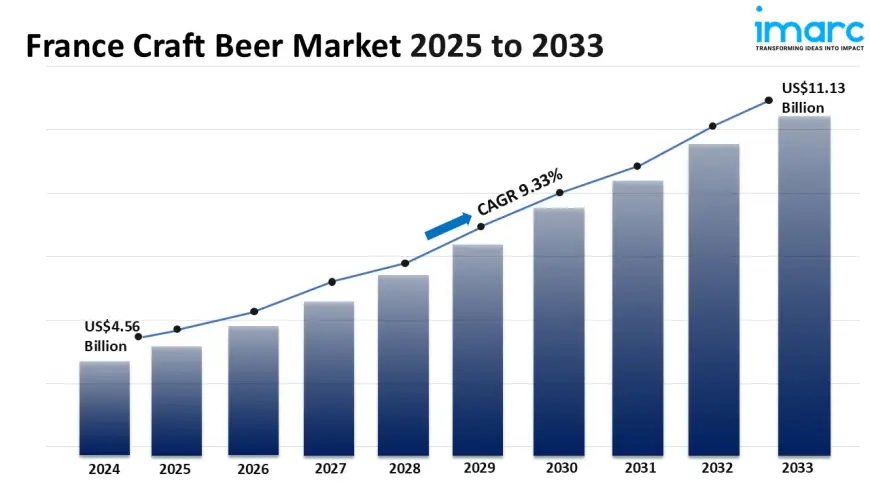France Craft Beer Market Size, Share, Demand, Trends and Forecast 2025-2033
The France craft beer market size reached USD 4.56 Billion in 2024. The market is projected to reach USD 11.13 Billion by 2033, exhibiting a growth rate (CAGR) of 9.33% during 2025-2033.

France Craft Beer Market Overview
Base Year: 2024
Historical Years: 2019-2024
Forecast Years: 2025-2033
Market Size in 2024: USD 4.56 Billion
Market Forecast in 2033: USD 11.13 Billion
Market Growth Rate (2025-33): 9.33%
The France craft beer market size reached USD 4.56 Billion in 2024. The market is projected to reach USD 11.13 Billion by 2033, exhibiting a growth rate (CAGR) of 9.33% during 2025-2033. The market is witnessing consistent growth driven by rising consumer preference for locally brewed, artisanal products. Innovation in flavors and a surge in demand among younger demographics are reshaping consumption patterns across both urban and regional areas. Distribution through supermarkets, specialty stores, and online platforms has further expanded market accessibility. Producers are increasingly focusing on sustainable practices and unique branding to differentiate in a competitive landscape. These dynamics continue to influence the France craft beer market share.
For an in-depth analysis, you can refer sample copy of the report: https://www.imarcgroup.com/france-craft-beer-market/requestsample
France Craft Beer Market Trends and Drivers:
A defining dynamic reshaping the French craft beer landscape is the profound embrace of terroir—a concept historically reserved for wine—which is now driving unprecedented innovation and regional identity within brewing. Moving beyond simply replicating international styles, discerning French brewers are embarking on a meticulous exploration of locally sourced, often hyper-regional, ingredients to create beers that are unmistakably and authentically French. This is not merely about using French hops like Strisselspalt; it is a deeper philosophical shift towards creating a sense of place in every glass. Brewers are experimenting with ingredients such as chestnuts from the Ardèche, oysters from Brittany for gose-style beers, lavender from Provence, and grapes from renowned wine regions for beer-wine hybrids. This focus on local provenance resonates powerfully with a consumer base that increasingly values transparency, authenticity, and the narrative behind their purchases. It allows microbreweries to differentiate themselves in a crowded market by offering a product that cannot be mass-produced or easily replicated elsewhere, effectively carving out protected geographical and cultural niches. This trend is elevating the entire category, shifting consumer perception of craft beer from a generic alcoholic beverage to a sophisticated, artisanal product worthy of the same contemplation as a fine wine or cheese, thereby securing a loyal and knowledgeable consumer base that seeks out these unique, location-specific expressions.
The market is experiencing a significant and sustained trend towards premiumization, where consumer demand is increasingly concentrated on higher-value, quality-driven craft beers rather than volume. This shift is characterized by a growing consumer willingness to pay a premium for beers that offer superior ingredients, complex flavour profiles, and exceptional craftsmanship. This dynamic is fuelled by a more educated and adventurous palate among French drinkers, who are moving away from traditional, mass-market lagers and seeking out sensory experiences. The consumption occasion itself is evolving from mere refreshment to a more deliberate, experiential act, often shared socially in specialized craft beer bars, taprooms, and during brewery tours. This has led to the proliferation of limited-edition releases, barrel-aged series, and complex styles like imperial stouts, wild ales, and sour beers that command higher price points and encourage slower, more thoughtful consumption. Furthermore, the rise of the "bière gastronomique" has seen craft beer successfully cement its place at the dining table, with restaurants increasingly offering curated beer pairings alongside or even in place of traditional wine menus. This entire movement elevates the economic viability of craft breweries, allowing them to focus on margin over volume, invest in higher-quality equipment, and engage in more experimental brewing, thus creating a virtuous cycle of quality improvement and consumer education that drives the market's sophistication and value.
A critical and increasingly non-negotiable dynamic is the industry-wide pivot towards embedded sustainability and hyper-localism, which is now a primary factor influencing both production strategies and consumer purchasing decisions. Environmental responsibility has evolved from a niche concern to a central tenet of the modern French craft beer identity, driven by a deeply eco-conscious consumer base that demands alignment with their values. Breweries are responding not as a marketing exercise but as a fundamental operational overhaul, implementing ambitious measures such as transitioning to renewable energy sources, investing in state-of-the-art water reclamation systems, and developing circular economy models by repurposing spent grain as livestock feed or for baking. Packaging is undergoing a revolution, with a strong move away from single-use plastics towards lightweight bottles, reusable growlers, and canning, which boasts a superior carbon footprint for transportation. The hyper-localism trend dovetails with this, emphasizing drastically shortened supply chains. Breweries are prioritizing ingredients from farms within a tight radius, not only to reduce food miles and support the regional economy but also to ensure unparalleled ingredient freshness that directly translates to flavour. This powerful combination of sustainability and localism builds immense brand trust and loyalty, as consumers perceive their purchase as a vote for a more ethical and environmentally sound industry, making it a decisive competitive advantage and a key indicator of a brewery's long-term viability and respect within the community.
France Craft Beer Market Industry Segmentation:
Product Type Insights:
- Ales
- Lagers
- Others
Age Group Insights:
- 21–35 Years Old
- 40–54 Years Old
- 55 Years and Above
Distribution Channel Insights:
- On-Trade
- Off-Trade
Regional Insights:
- Paris Region
- Auvergne-Rhône-Alpes
- Nouvelle-Aquitaine
- Hauts-de-France
- Occitanie
- Provence Alpes Côte d’Azur
- Grand Est
- Others
Competitive Landscape:
The competitive landscape of the industry has also been examined along with the profiles of the key players.
Ask Our Expert & Browse Full Report with TOC & List of Figure: https://www.imarcgroup.com/request?type=report&id=38102&flag=C
Key highlights of the Report:
- Market Performance (2019-2024)
- Market Outlook (2025-2033)
- COVID-19 Impact on the Market
- Porter’s Five Forces Analysis
- Strategic Recommendations
- Historical, Current and Future Market Trends
- Market Drivers and Success Factors
- SWOT Analysis
- Structure of the Market
- Value Chain Analysis
- Comprehensive Mapping of the Competitive Landscape
Note: If you need specific information that is not currently within the scope of the report, we can provide it to you as a part of the customization.
About Us:
IMARC Group is a global management consulting firm that helps the world’s most ambitious changemakers to create a lasting impact. The company provide a comprehensive suite of market entry and expansion services. IMARC offerings include thorough market assessment, feasibility studies, company incorporation assistance, factory setup support, regulatory approvals and licensing navigation, branding, marketing and sales strategies, competitive landscape and benchmarking analyses, pricing and cost research, and procurement research.
Contact Us:
IMARC Group
134 N 4th St. Brooklyn, NY 11249, USA
Email: [email protected]
Tel No:(D) +91 120 433 0800
United States: +1-201971-6302
What's Your Reaction?
 Like
0
Like
0
 Dislike
0
Dislike
0
 Love
0
Love
0
 Funny
0
Funny
0
 Angry
0
Angry
0
 Sad
0
Sad
0
 Wow
0
Wow
0


















































